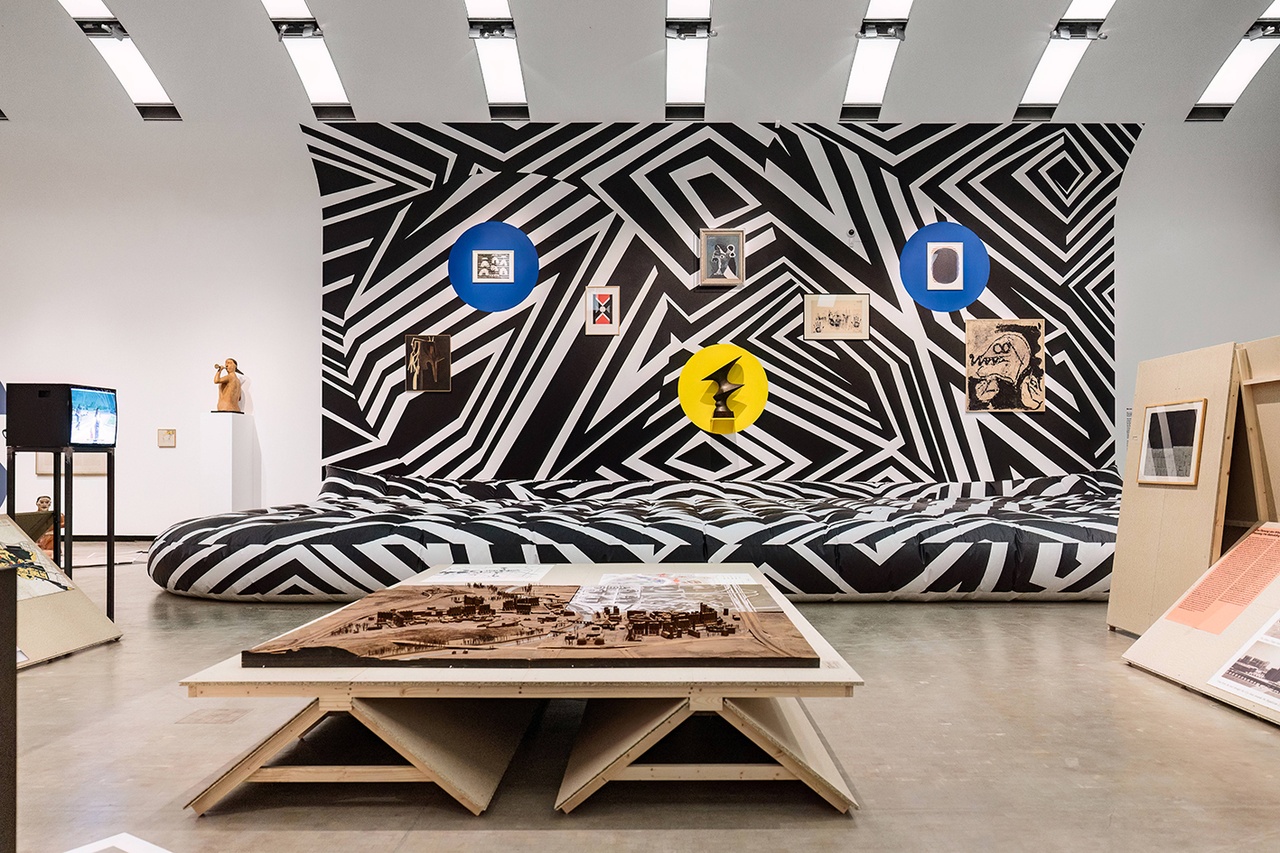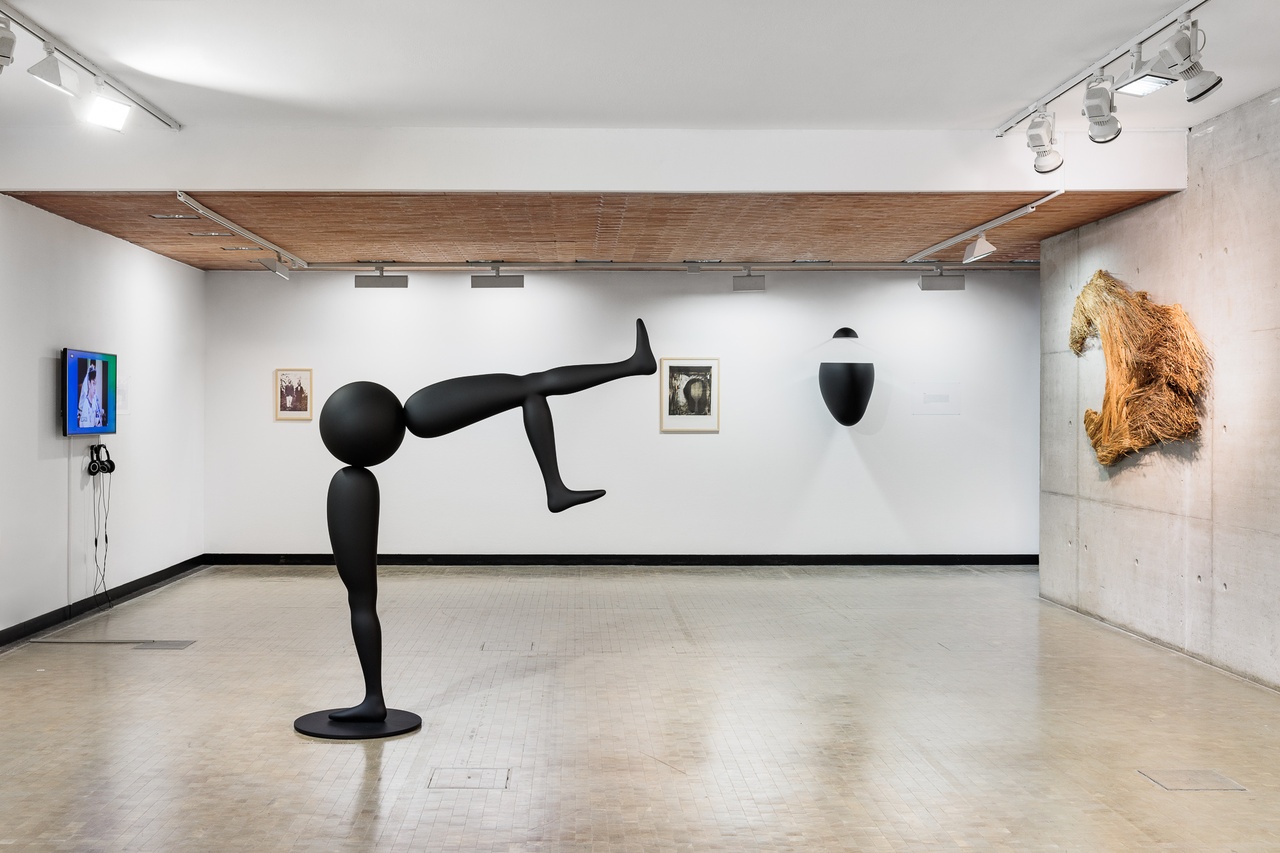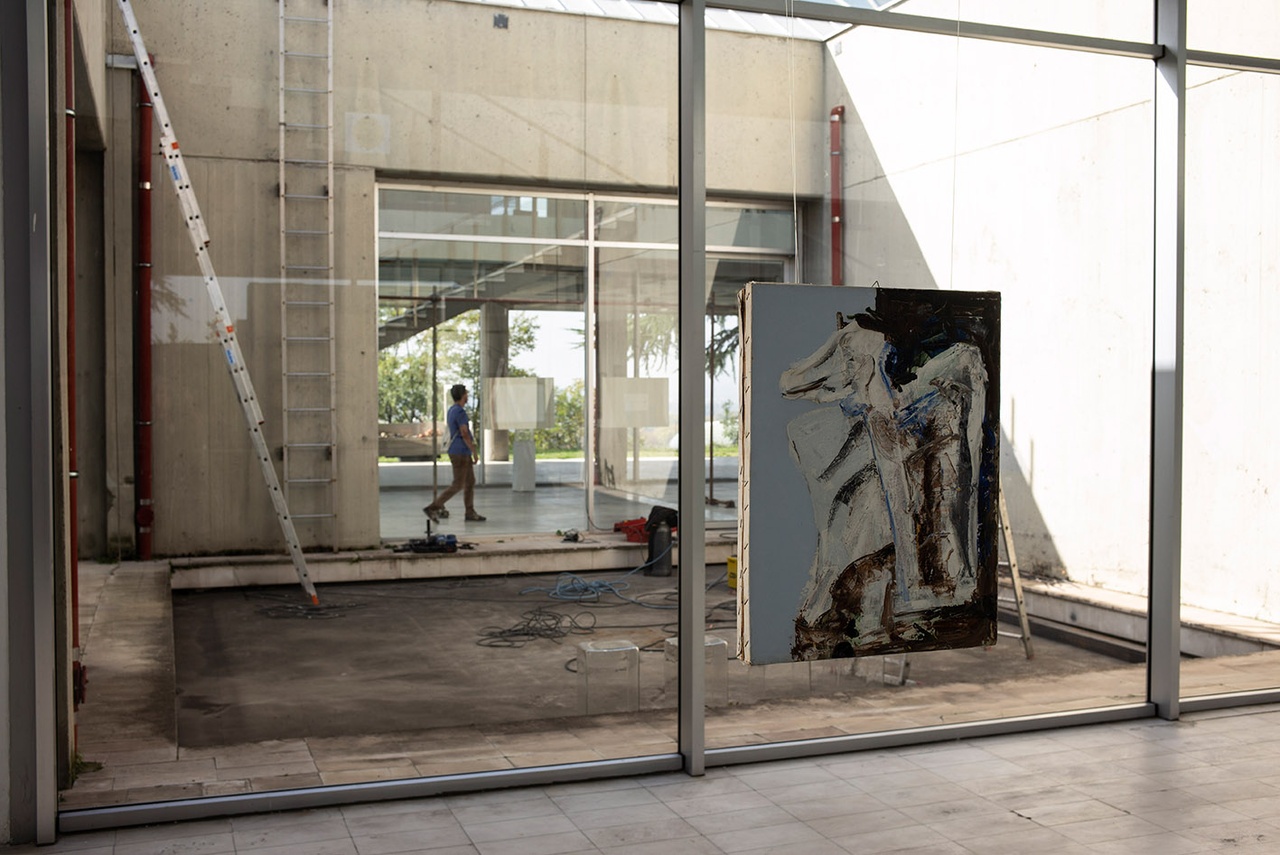COLLECTING OUT OF/AS SOLIDARITY Sabeth Buchmann and Ana Hoffner ex-Prvulovic* on “No Feeling is Final. The Skopje Solidarity Collection” at the Kunsthalle Wien

„No Feeling Is Final. The Skopje Solidarity Collection“, Kunsthalle Wien, 2023, Ausstellungsansicht
According to the writings of the Slovenian art theorist and curator Igor Zabel (1958–2005), there is an ongoing ethnicization effect created by the culturally dominant universalism of the West, a phenomenon perpetuated in conceptions of multiculturalism and globalization. [1] Against these conceptions, Zabel focused on relations of cultural exchange between the “former West” and the “former East” to form the basis for an analysis of the globalized art and exhibition markets that is dedicated to a reinstitution of art by distancing itself not only from a homogenized concept of modernity but also from a postmodern notion of identity. Zabel’s attempt to think curatorial practice together with institutional analysis and art criticism resonates perfectly with an exhibition in Vienna about the history of a solidarity museum, the Museum of Contemporary Art Skopje (MoCA Skopje), initiated by the curatorial collective What, How & for Whom/WHW at the Kunsthalle Wien.
“No Feeling is Final. The Skopje Solidarity Collection” represents an exploration of how the principle of donation has the potential to create a more egalitarian policy of collecting. The exhibition is placed in a discursive setting that has only recently begun to form around art institutions that have emerged from the network of relations between the non-aligned states – including the traveling exhibition “Southern Constellations: The Poetics of the Non-Aligned” (Moderna Galerija, Ljubljana, 2020), “Collections for a Solidary Future” (Galerija Slovenj Gradec in cooperation with the Contemporary Art Centre of Montenegro in Podgorica, – the Laboratory of the Collection of the Non-Aligned Movement, and the Museum of Modern and Contemporary Art Koroška, 2022), and “Rewinding Internationalism” (Van Abbemuseum in Eindhoven, 2022). After a devastating earthquake in July 1963 that destroyed 80 percent of what is now the North Macedonian capital, an international reconstruction effort began that successfully escaped the political divisions of the postwar period. From the then non-aligned Yugoslavia, a successful call went out to artists all over the world to contribute to the collection of the newly founded Museum of Contemporary Art in Skopje – among these contributors were renowned names such as Getulio Alviani, Maria Bonomi, Alexander Calder, Olga Jančić, Jasper Johns, Zoltán Kemény, Wifredo Lam, Sol LeWitt, Oto Logo, Meret Oppenheim, Pablo Picasso, Bridget Riley, Niki de Saint Phalle, Kumi Sugai, Dimo Todorovski, Victor Vasarely, and others.

„No Feeling Is Final. The Skopje Solidarity Collection“, Kunsthalle Wien, 2023, Ausstellungsansicht
The all-encompassing framework of “solidarity” as the basis of a transformational exchange is expressed in the Kunsthalle’s invitation to the artists Brook Andrew, Yane Calovski and Hristina Ivanoska, Siniša Ilić, Iman Issa, and Gülsün Karamustafa to bring contemporary perspectives to the museum: perspectives guided by the question of whether collection politics can go beyond accumulative profit orientation and be useful in overcoming ethnicized and hierarchical differences.
The most convincing proposal in this regard is made by Calovski and Ivanoska, in that they exhibit works by the Macedonian artists Dushan Perchinkov and Aneta Svetieva, which were acquired for the MoCA collection although these artists never received an invitation to donate their works. In response to ethnographic mechanisms of in/exclusion and colonialist self-enrichment in museums, Calovski and Ivanoska’s spatial model is inspired by Oskar and Zofia Hansen’s open form: understanding the museum as a temporarily utilized architecture that encapsulates its own void and can make itself disappear, Ivanoska’s texts and graphics emerge as surface structures on the border of the legible. This “spiritual” materialism is also reflected in Calovski’s electronically controlled abstract sculptures.
In the tradition of institutional critique reflecting on class, gender, and colonialism, Gülsün Karamustafa confronts the fragmentarily cited presentation style of the Skopje Solidarity Collection with her own assemblage of objects, including personal souvenirs and bric-a-brac. Her gesture points at the dimensions of trade and taste as well as infrastructural categories of travel and transport from a socio-aesthetic perspective on the distinctions and intersections of public and private collections.
Iman Issa, on the other hand, responds to WHW’s premise with a linkage of artistic and curatorial practices reminiscent of recontextualizations of works from classical modernism using institutional and discourse analysis: I, the Artwork (2023) consists of a spatial composition of her own works with pieces by Bronisław Chromy, Josip Diminić, Ivan Sabolić, Gligor Stefanov, Olga Peczenko-Srzednicka, and Beáta Széchy. The non-hierarchical juxtaposition of museum formats of presentation and mediation (object, painting, video, wall text, work label) is in contradiction to the museological claim to be a repository of knowledge that transcends time and place.

Elfie Semotan, „Untitled (Museum of Contemporary Art Skopje)“, 2022
The exhibition is conceived as a collective research project, and its spatial center is constituted by architectural and urban designs created after the earthquake of 1963, including Kenzō Tange’s Master Plan. As not all of these designs were implemented, the city of Skopje was to remain in an “unfinished” state for a long time, which, as the clearly arranged documentation shows, was exploited by the right-wing nationalist government of North Macedonia as part of the “Skopje 2014” architectural project. That center-city development, imposed in an autocratic manner using destructively imposed mall architecture, demonstrates an antagonism between progressive and conservative urban policy that is typical of the 20th century, an antagonism that continues to play out in modernist design and the hostilities against it to this day. Skopje also exemplifies the consequences of massive privatization and liberalization in post-socialism and the mostly invisible struggles and actions undertaken by the civilian population. In this case, such a movement originated among architecture students under the name “Prva Arhi Brigada” (First Archi Brigade) and developed into a visible protest that lasted for many years. Unfortunately, Elfie Semotan’s photographs, selectively and sometimes improvisationally presented, are rarely able to convey the reconstruction of Skopje that began under the sign of socialist modernism and continued under the sign of conservative neoliberalism.
At the same time, the exhibition tends to leave out the relationship between artistic/aesthetic production and socio-institutional reproduction, which determines collection policies as possessive individualistic practices. Thus, Siniša Ilić’s pedestal landscape, arranged with original museum furniture, creates the impression of nostalgic authenticity, which is tantamount to an uncritical reproduction of given representational relationships, but above all a fixation on the experience of violence in post-war sculpture. Although Brook Andrew’s display, inspired by Wiradjuri carvings and including a literally inflated giant sculpture, seeks to break down the museum setup of colonial modernism, it still fails to convey the associated gender representation of the Skopje Solidarity Collection in a way that is critical of its history.
Thus, the exhibition sometimes fails to account for the implications of subjectivity, exchange, and gifting, which have often been viewed in feminist discourses as ideas that stand in contrast to dominant cultural economies. [2] The idea of transnational kinship, which is not first and foremost constituted by nation, that is, by heteronormative chains of reproduction and inheritance, would have been equally fitting. Last but not least, it would also be necessary to overcome the naive view that racism can be defeated by philanthropy and friendship. Racist, nationalist, and heteronormative structures can easily persist in a multicultural society and a supposedly more just institutional economy. Raising these issues is not an objection to the highly exciting and support-worthy proposal to translate solidarity-based collection concepts from the time of socialist non-alignment politics into contemporary exhibition practice; rather, it points at possibilities for a further development of historical materialist approaches and perspectives. After all, “No Feeling is Final” begins with a reference to the brutal destruction of Skopje by the Habsburgs as an act of revenge against the Ottoman Empire in 1689. The fact that WHW has shown this exhibition in Vienna is therefore nothing less than a literally site-specific look at imperialist-racist devastation built on the Orientalization of the “former East.”
The presentation of the Skopje Solidarity Collection thus constitutes a highly complex undertaking, linking the history of the Habsburg monarchy’s colonialism with that of socialist non-alignment policies and retrogressive neoliberalism. There is little else in the current exhibition landscape that is as relevant: especially since “No Feeling is Final” creates a sense of the need for a present shared in solidarity at a time when Cold War narratives are no longer just history.
The exhibition recalls in particular the ending of the Socialist Federal Republic of Yugoslavia through war and the re-nationalization that, as is well known, also characterizes Russia’s aggressive war on Ukraine. Finally, to propose the principle of donation as an aesthetic, ethical, and economic matrix of art collecting in this situation also gives expression to the hope that the (presumed) ownership of cultural identity does not necessarily have to coincide with the (presumed) ownership of objects.
Translation: Ana Hoffner ex-Prvulovic*
“No Feeling is Final. The Skopje Solidarity Collection,” Kunsthalle Wien, Vienna, April 20, 2023–January 28, 2024.
Sabeth Buchmann is a professor of modern and postmodern art history at the Akademie der Bildenden Künste, Vienna, and coeditor of PoLYpeN, a series on art criticism and political theory (b_books, Berlin). Her recent publications include Kunst als Infrastruktur (Verlag Walther König, 2023) and Broken Relations: Infrastructure, Aesthetic, and Critique (coeditor; Spector, 2022).
Ana Hoffner ex-Prvulovic* is an artist, researcher, and writer. She* is interested in queerness, displays of global capital, coloniality and the East, forms of escape, early psychoanalysis, and politics of memory and war. Recent solo exhibitions include “Active Intolerance” at Kunstverein Braunschweig (2023), and “Ana Hoffner ex-Prvulovic*” at Kunsthalle Wien (2021). The catalogue Contemporary/Unconscious, based on her* exhibition at Kunsthalle Wien, was published by Sternberg Press in 2023. She* is currently a professor for artistic research at Mozarteum University Salzburg.
Image credit: 1+2. Kunsthalle Wien, photo www.kunst-dokumentation.com; 3. © Elfie Semotan
Notes
| [1] | See Igor Zabel, Contemporary Art Theory (Zurich: JRP Ringier, 2012). |
| [2] | For example here: Gayle Rubin, “The Traffic in Women: Notes on the ‘Political Economy’ of Sex,” in Toward an Anthropology of Women, ed. Rayna Reiter (New York: Monthly Review Press, 1975); Anne McClintock: Imperial Leather: Race, Gender and Sexuality in the Colonial Contest (New York: Routledge, 1995); Rosalyn Diprose, “Women’s Bodies Giving Time for Hospitality,” in Hypatia 24, no. 2 (2009): 142–63. |
